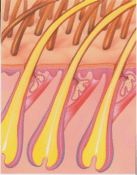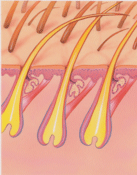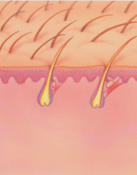Types of Female Hair Loss / Thinning Hair
The following is a guide to some of the most common hair loss/thinning hair causes in women, complete with a recommended treatment approach. Please read through each of the following causes of hair loss to help you correctly identify the reason for your hair loss/thinning hair. The following is to be used as a guide and is not intended to diagnose a hair loss condition. If you feel the reason for you hair loss/thinning hair is not covered in this guide, or you wish for further clarification, please call 1800 966 904 to speak with a hair loss specialist or click Contact Us to have a specialist contact you.
80% of all hair loss/thinning hair cases in women are due to a genetic condition called Androgenetic Alopecia (AGA), commonly known as Female Pattern Hair Loss. Only 20% of hair loss/thinning hair cases present for other reasons, e.g. unhealthy scalp, poor nutrition, stress, age, traction alopecia, trichotillomania, traumas, medications, hypothyroidism, alopecia areata, scalp disease, surgery, autoimmune diseases, iron deficiency and hormone imbalance.
Female Pattern Hair Loss typically begins gradually in females and is seen as a loss of hair density over the top (vertex) and the anterior mid-scalp area (receding hairline). This type of hair loss doesn’t usually happen all at once – even though it may seem that way. There is a process in the body that occurs over time that leads to the hair follicles becoming irretrievable (dormancy).
The small amount of testosterone naturally present in females is hardened by an enzyme called ‘5 alpha reductase’ in the body, creating a build-up under the scalp called dihydrotestosterone (DHT). As the DHT hardens over time it slowly restricts the food source supplied to the hair follicle causing the hair follicle to fall. Each time the new hair regrows, it does so thinner, shorter, and with less pigmentation (loss of colour). Over time these new hairs become so small that they are no longer visible. This process is referred to as ‘miniaturisation’ (as shown in the diagram below).



Miniaturisation only occurs because of DHT build up.
What can be done about miniaturisation/female pattern hair loss (AGA)?
Treatment to recover hair follicles is only possible for hair follicles in the miniaturisation stage. These treatable hair follicles are referred to as active follicles. Therefore it is important to commencement treatment as early as possible at the first signs of thinning.
Miniaturisation only occurs when there is a DHT build up, and this only ever presents its self in one female hair loss condition: Female pattern hair loss (AGA).
Hair Health Australia recommends an effective Natural 5-alpha reductase inhibitor (DHT Blockers) NHC Natural Hair Loss Capsules which are taken twice daily in a soft capsule form. Each capsule contain a cocktail of highly potent natural DHT inhibitors, which form a safe non drug formulation with no side effects.
Hair Health Australia recommend the use of the Ultimate Hair Growth Pack for Female Pattern Hair Loss (AGA) to naturally stop excessive hair loss and maximise hair regrowth.
- Recommend: Ultimate Hair Growth Pack
What Hair products containing toxic chemicals can cause hair loss/thinning hair
Hair products containing chemicals such as Sulphates, SLS, Parabens, Propylene Glycol, Grapefruit Seed Extract and added Fragrances can cause hair loss / thinning hair in women. Hair dyes, permanents, relaxers, shampoo and conditioners with these toxic chemicals do serious damage to the hair and scalp whether they contain dye or not. The toxic chemicals must be detoxified by the liver, and are identified by the immune system as foreign invaders. The health of the liver and the immune system are compromised by the use of these products. An immune system busy fighting off an invasion of foreign chemicals may not be able to prevent infection or identify and destroy aberrant cells. The majority of these products that are sold in supermarkets, chemists, pharmacy and discount stores have a toxic effects on a persons immune system and impede hair growth and cause hair loss / thinning hair.
Hair Health Australia recommend the use of the Ultimate Hair Growth Pack for Female Pattern Hair Loss (AGA) to naturally stop excessive hair loss and maximise hair regrowth.
- Recommend: Ultimate Hair Growth Pack
Other possible causes of hair loss
Unhealthy Scalp
An unhealthy scalp environment can play a significant role in hair thinning by contributing to miniaturisation or causing damage. Air and water pollutants, environmental toxins, conventional styling products and excessive amounts of sebum have the potential to build up on the scalp blocking hair follicles and consequently causing their deterioration. It can also physically restrict hair growth or damage the hair cuticle, leading to hair that is weakened and easily broken off before its natural lifecycle has ended.
- Recommend: Shampoo & Conditioner Pack for normal to dry hair or Shampoo & Conditioner Pack for normal to oily hair
Poor Nutrition
Studies have shown that poor nutrition, limited food intake, and deficiencies in certain nutrients can cause thinning. These include deficiencies of biotin, protein, zinc and poor human iron metabolism, although complete baldness is not usually seen. A diet high in animal fats (often found in fast food) and vitamin A is also thought to have a negative effect on hair loss / thinning hair.
- Recommend: Hair Growth Capsules for Women and Shampoo & Conditioner Pack for normal to dry hair or Shampoo & Conditioner Pack for normal to oily hair can be safely used as an extra support to the hair.
Stress
Stress has been shown to restrict the blood supply to capillaries, inhibiting oxygen and nutrient uptake of hair follicles and inhibiting hair growth, in an effect similar to that from having poor circulation.
- Recommend: Shampoo & Conditioner Pack for normal to dry hair or Shampoo & Conditioner Pack for normal to oily hair together with the Natural Hair Loss Solution. If the stress related hair loss has been present for some time the Ultimate Hair Growth Pack is recommend for a minimum of 3 months.
Age
Gradual thinning of hair with age is a natural condition known as involutional alopecia. This is caused by an increasing number of hair follicles switching from the growth – or anagen – phase, into a resting – or telogen – phase. The end result is that the remaining hairs becoming fewer in number.
- Recommend: Ultimate Hair Growth Pack
Traction Alopecia
Traction alopecia is most commonly found in people with ponytails or cornrows; who predominately pull on their hair with excessive force. In addition, rigorous brushing, heat styling, rough scalp massage can damage the cuticle; which is the hard outer casing of the hair. This causes individual strands to become weak and break off, reducing the overall hair volume.
- Recommend: Shampoo & Conditioner Pack for normal to dry hair or Shampoo & Conditioner Pack for normal to oily hair
Trichotillomania
Trichotillomania is the loss of hair caused by compulsive pulling and bending of the hairs. Onset of this disorder tends to begin around the onset of puberty and usually continues through adulthood. Due to the constant extraction of the hair roots, permanent hair loss can occur.
- Recommend: Speak with your doctor and discuss options including counselling – NHC recommends the use of the Micro-needling Roller to help manage the frequency of need for the sensation of pulling. Speak to a hair loss specialist to help on 1800 996 904 or click on this link to have a specialist contact you.
Traumas
Traumas such as major surgery, poisoning, and severe stress may cause a hair loss condition known as telogen effluvium, in which a large number of hairs enter the resting phase at the same time, causing shedding and subsequent thinning.
- Recommend: Ultimate Hair Growth Pack
Worriesome
Worriesome hair loss often follows childbirth without causing actual baldness, In this situation the hair is actually thicker during the pregnancy due to increases circulating oestrogens. After the child is born the oestrogen levels fall back to normal pre-pregnancy levels and the additional hair foliage drops out. A similar situation occurs in women taking the fertility-stimulating drug ‘clomiphene’.
- Recommend: Ultimate Hair Growth Pack and if you are still breastfeeding to only use Shampoo & Conditioner Pack for normal to dry hair or Shampoo & Conditioner Pack for normal to oily hair and Micro-needling Roller without any solution or capsules.
Medications
Temporary or permanent hair loss can be caused by several medications, including those for blood pressure problems, diabetes, heart disease and cholesterol. Any that affect the body’s hormone balance can have a pronounced effect: these include the contraceptive pill, hormone replacement therapy, steroids and acne medications.
- Recommend: Speak with your doctor before taking Hair Growth Capsules for Women, Shampoo & Conditioner Pack for normal to dry hair or Shampoo & Conditioner Pack for normal to oily hair and Natural Hair Loss Solution can be safely used with the Micro-needling Roller.
Hypothyroidism
Hypothyroidism (an under-active thyroid) and the side effects of its related medications can cause hair loss, typically frontal, which is particularly associated with thinning of the outer third of the eyebrows (also seen with syphilis). Hyperthyroidism (an over-active thyroid) can also cause hair loss, which is parietal rather than frontal.
- Recommend: Speak with your doctor before taking Hair Growth Capsules for Women, Shampoo & Conditioner Pack for normal to dry hair or Shampoo & Conditioner Pack for normal to oily hair and Natural Hair Loss Solution can be safely used with the Micro-needling Roller.
Alopecia Areata
Alopecia areata is an autoimmune disorder also known as “spot baldness” that can result in hair loss ranging from just one location (Alopecia areata monolocularis) to every hair on the entire body (Alopecia areata universalis). Although thought to be caused by hair follicles becoming dormant, what triggers alopecia areata is not known. In most cases the condition corrects itself, but it can also spread to the entire scalp (alopecia totalis) or to the entire body (alopecia universalis).
Facts of Alopecia Areata
1. Alopecia Areata is a hair-loss condition which usually affects the scalp.
2. Alopecia Areata typically causes one or more circular patches of hair loss.
3. Alopecia Areata affects both genders.
4. Alopecia Areata is an autoimmune disorder, in which the immune system attacks hair follicles leading to dormancy.
5. For most patients, the condition resolves without treatment within a year, but can be helped along with NHC products to speed up recovery.
6. A number of treatments are known to aid hair regrowth and prevent further loss in Alopecia Areata patients by stimulating the dormant follicles. Multiple treatments may be necessary, and no one treatment consistently works for all patients.
Recommend: Speak to a Hair Loss Specialist on 1800 996 904 to discuss prior treatments if any so a customised structured treatment approach can be recommended to best suit you or click “CONTACT US” to have a specialist contact you.


